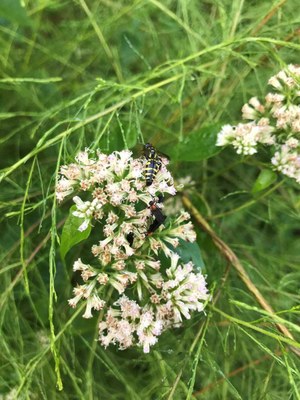Potter Wasps
October 2019
by Ranger Amy
 Have you ever found a tiny clay pot stuck to your window screen or on the side of a building? What artist creates such a unique clay jug?
Have you ever found a tiny clay pot stuck to your window screen or on the side of a building? What artist creates such a unique clay jug?
Potter wasps are the creators of these small pieces of art. These wasps are not your typical wasp.
Artists at work
Like mud daubers, potter wasps live solitary lives. Since they don’t protect a colony, they are non-aggressive.
Potter wasps are beneficial artists. They provide pest control while making tiny clay pots that protect their young.
Now is a great time to spot potter wasps flying among flowers drinking nectar alongside other pollinators.
Providing for the next generation
 Unlike bees, potter wasps do not feed their young pollen; they feed them live insects. To do this they first create a haven for their young to grow in: the clay pot. They use saliva and mud to construct the pot.
Unlike bees, potter wasps do not feed their young pollen; they feed them live insects. To do this they first create a haven for their young to grow in: the clay pot. They use saliva and mud to construct the pot.
When it is nearly complete, the female wasp searches for caterpillars or spiders. She paralyzes her prey with a sting and places them in the pot.
Once the pot is full of fresh insects that cannot move, she lays a single egg on the inside and seal it shut.
After it hatches, the larval wasp has plenty of fresh defenseless insects to munch on. When the food is gone the larval wasp chews a hole on the side of the pot and enters the world.
If you find a clay pot that is still completely intact, I recommend leaving it alone. If you see a hole on the side, you can remove it.
Garden companions
Although I’m not particularly fond of wasps, I don’t mind the non-aggressive potter wasp. I can work alongside them in the garden and appreciate them as pollinators and pest control.
Next time you find a small clay pot remember that potter wasps are beneficial little artists by providing pest control and a creative means to protect their young.
